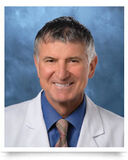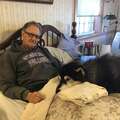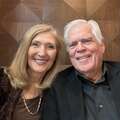Patient Success Week: After Fainting & Aortic Valve Surgery, Laurence Gets Back to Pick-Up Basketball
By Adam Pick on July 17, 2015
As “2015 Patient Success Week” continues, I think it’s a great time to address an important symptom of heart valve disease — fainting. Needless to say, fainting can be very dangerous and very indicative of valvular disorders that have progressed to severe status. Several patients in our community, including Randy Heimerl, experienced this dislocating symptom.
For this reason, I wanted to share the story of Laurence Msall, a 52-year old bicuspid aortic valve patient, who I recently met in Chicago, Illinois. After fainting while exercising, Laurence didn’t waste any time getting an aortic valve replacement. Here’s why…
Many, many, many thanks to Laurence Msall for taking the time to share his patient success story with our community. We are so happy to hear that Laurence’s recovery went well and that he is back on the basketball court just 4 months after surgery.
I would also like to extend an extraordinary thanks to Dr. Patrick McCarthy, Dr. James Thomas, Dr. Robert Bonow, Dr. Chris Malaisre, Dr. Hyde Russell, Dr. Phan and the entire Northwestern team — Barbara Garren, Lola Banjo, Jane Kruse, Benjamin Hill, Colleen Clennon and Eric Alvarez — for their support of this patient community.
- Watch the “Bicuspid Aortic Valve Conference” for Patients
- See Northwestern’s Bicuspid Aortic Valve Patient Microsite
- Learn about Dr. Patrick McCarthy, Laurence’s surgeon
Keep on tickin’ Laurence!
Adam
P.S. For the hearing impaired members of our community, I posted a transcript of Laurence’s video below:
Jim Thomas: My name is Jim Thomas and I’m the Director of the Center for Heart Valve Disease at Northwestern Medicine. I’ve been in practice for about 25 or 26 years. I’ve had a lot of experience in clinical aspects of echocardiography, into research in it. Several things attracted me to the whole issue of valvular heart disease. You could take patients who were just as sick as they could possibly be and have a very good likelihood of returning them to a completely normal life with modern therapy. There are several missions that we have at the Center for Heart Valve Disease. We of course want to deliver outstanding care to our patients. We also want to conduct cutting edge research. We want to attract patients with serious heart valve disease from around the region, around the county, and around the world to come here for their evaluation and treatment. Surgically, we are doing several hundred complex heart valve operations annually there. We’re doing an increasing number of percutaneous interventions, for treating severe aortic stenosis and mitral regurgitation in patients that really are just too sick to undergo open-heart surgery.
Laurence Msall: My name is Laurence Msall. I’m 52 years old. I live in the Greater Chicago area. The symptoms that I had were that when I would exercise, and particularly when I’d go running along the lake front, almost immediately within about a minute or two of running I would get lightheaded, then I would faint. I definitely had a feeling that something was not right and it was a rather frightening experience.
Jim Thomas: There are several very common forms of valvular heart disease. Perhaps the most common that we see is aortic stenosis that can result either from a bicuspid aortic valve or from just old age and calcification.
Laurence Msall: I was diagnosed about seven years ago with having a failing aortic valve. I had stenosis. The meant, basically, there was not sufficient blood flow through my bicuspid aortic valve.
Jim Thomas: The other types of valvular heart disease that we see involve mitral regurgitation, either from myxomatous degeneration with mitral valve prolapse and flail. Of course then there are a host of other types of diseases involving the tricuspid valve, the pulmonic valve, and then complex combinations of all of the above.
Laurence Msall: Dr. McCarthy treated me with both respect and with a sympathetic understanding of the fears that I had related to the surgery, but he was also very candid. He presented the facts. He presented the options. When I asked him the ultimate question, what would you do if you were in my situation? He didn’t flinch as to what he would do, and it’s turned out to be fantastically beneficial advice. I had the replacement of my bicuspid aortic valve with a valve that came from the pericardium of a cow’s heart. My recovery was smooth. It was right within, I believe 12 hours of the surgery, they had me up and walking. My strength began to come back. I experienced cardiac rehab, in which I saw major leaps and bounds with my strength. I was able to get back to work within a month. Within four months, I was starting to jog slowly again. Nine months, I was back to playing pick-up basketball and jogging along the lake front again.
Jim Thomas: My usual advice to patients with valvular heart disease is to relax a little bit. Yes, you have a problem with your heart but if you had to choose something to be wrong with your heart, you’ve made a pretty good choice. We can follow you along for a long period of time before you need anything done, and when that day comes, we have excellent options for you. I think we may do it a little better at Northwestern but there are some excellent centers around the country.
Laurence Msall: I already recommend Northwestern and the Bluhm Cardiovascular Center to anyone who has any sort of heart or heart-related issues that need to be resolved.
|
Dirk Richmond says on July 18th, 2015 at 1:52 pm |
|
Fainting after exercise was my first indication something was wrong. The first time I came home from walking at the High School. When I got out of the truck I went down like a ton of bricks. From the on I had to keep walking, keep my heart rate up, until I got in the house and could sit. I took my blood pressure and watched it dropp off the cliff as I sat but it would slowly build back up. It took a couple years for it to dawn on me it was more than just being out of shape. I was fortunate to have surgery at Northwestern with Dr McCarthy and some rehab at RIC. |
 |












